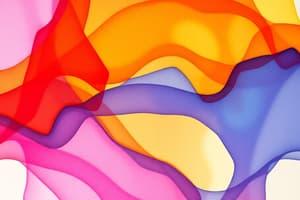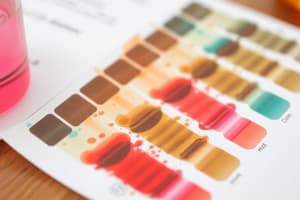Podcast
Questions and Answers
What does a pure sample show on a chromatogram?
What does a pure sample show on a chromatogram?
- A gradient of colors
- One spot (correct)
- Three or more spots
- Two distinct spots
Paper chromatography can only separate color substances.
Paper chromatography can only separate color substances.
False (B)
Name one application of chromatography techniques.
Name one application of chromatography techniques.
To separate and identify types of sugars in fruit juice.
In chromatography, the substance that is attracted to the surface of the paper is said to be __________.
In chromatography, the substance that is attracted to the surface of the paper is said to be __________.
Match the following types of chromatography with their characteristics:
Match the following types of chromatography with their characteristics:
Which of the following describes how substances are separated in chromatography?
Which of the following describes how substances are separated in chromatography?
More strongly adsorbed substances move faster up the chromatography paper.
More strongly adsorbed substances move faster up the chromatography paper.
What is the mobile solvent in paper chromatography typically composed of?
What is the mobile solvent in paper chromatography typically composed of?
Which solvent is more effective at dissolving solutes that are less soluble in organic solvent?
Which solvent is more effective at dissolving solutes that are less soluble in organic solvent?
The solvent level must be above the pencil line to ensure proper chromatography.
The solvent level must be above the pencil line to ensure proper chromatography.
What is the purpose of drawing a baseline on chromatography paper?
What is the purpose of drawing a baseline on chromatography paper?
The resulting chromatography paper with separated spots of colours is called a __________.
The resulting chromatography paper with separated spots of colours is called a __________.
Match the following terms with their definitions:
Match the following terms with their definitions:
What happens if the tiny spot of the mixture is too large?
What happens if the tiny spot of the mixture is too large?
The Rf value changes depending on temperature and the solvent used.
The Rf value changes depending on temperature and the solvent used.
Why is it important to cover the chromatography setup during the experiment?
Why is it important to cover the chromatography setup during the experiment?
Flashcards
Chromatography
Chromatography
The process of separating a mixture of components based on their different affinities for a stationary phase and a mobile phase.
Paper Chromatography
Paper Chromatography
A type of chromatography where the stationary phase is a paper and the mobile phase is a solvent.
Chromatogram
Chromatogram
The paper with separated components in paper chromatography.
Pure substance in chromatography
Pure substance in chromatography
Signup and view all the flashcards
Speed of separation in chromatography
Speed of separation in chromatography
Signup and view all the flashcards
Mobile solvent
Mobile solvent
Signup and view all the flashcards
Adsorption
Adsorption
Signup and view all the flashcards
Absorption
Absorption
Signup and view all the flashcards
Why is water a good solvent?
Why is water a good solvent?
Signup and view all the flashcards
Why avoid ink pens for the baseline?
Why avoid ink pens for the baseline?
Signup and view all the flashcards
Why should the starting spot be small?
Why should the starting spot be small?
Signup and view all the flashcards
Why is vertical orientation important?
Why is vertical orientation important?
Signup and view all the flashcards
Why should the solvent level be below the baseline?
Why should the solvent level be below the baseline?
Signup and view all the flashcards
How does the solvent create separation?
How does the solvent create separation?
Signup and view all the flashcards
What is the Retention Factor (Rf)?
What is the Retention Factor (Rf)?
Signup and view all the flashcards
What is a chromatogram?
What is a chromatogram?
Signup and view all the flashcards
Study Notes
Paper Chromatography
- Chromatography separates colours, pigments, and dyes, now also colourless substances
- Paper chromatography separates small amounts of similar substances
- A chromatogram shows the separated components on the paper
Distinguishing Pure and Impure Samples
- A pure sample produces only one spot on a chromatogram
- Chromatography includes techniques like gas and thin-layer chromatography
- Chromatography identifies tiny amounts of substances, potentially less than 1 picogram
Applications of Chromatography
- Separates and identifies sugars (e.g., sucrose, maltose, glucose) in fruit juice
- Separates and identifies amino acids in protein samples
- Detects illegal drugs used in drinks/food
- Detects illegal chemicals in food
- Detects excessive drug use in athletes (e.g., steroids, beta-blockers) in urine samples
- Screens national service personnel for drug use in urine samples
Principle of Chromatography
- Dyes move at different speeds due to differences in
- Solubility in the solvent
- Adsorption on the paper
- Greater solubility leads to faster movement and higher spot position
- Different solutes have different solubilities, leading to separation
Procedure for Paper Chromatography
- Draw a baseline on chromatography paper with a pencil
- Ink pens are not used as ink mixes with the solvent, leading to unwanted spots
- Spot a small, dry sample of the mixture onto the base line, repeat 2-3 times
- Large, smudged spots produce overlapping spots and poor separations
- Place the paper in a tube or beaker with solvent, upright using a support (e.g., cork)
- Solvent level needs to be below the baseline to prevent the ink mixture from dissolving
- Allow the solvent to travel up the paper
- Solvent travels by capillary action
- Remove the paper when the solvent nears the top, marking the solvent front
- Spots are separated due to differing solubilities and adsorption rates.
Identifying Components
- Components more soluble travel further from the start line than those less soluble
- Similar components travel the same distance
Retention Factor (Rf)
- Rf = distance travelled by solute / distance travelled by solvent front (constant at a set temperature)
- Rf is unique for each substance, used to identify them
- Rf values differ based on the solvent
Separating Colourless Substances
- Locating agents react with colourless substances to reveal visible spots
- Ninhydrin reacts with amino acids to produce purple spots
- Silver nitrate/sodium hydroxide creates a brown spot for sugars
- UV light can highlight colourless substances that fluoresce under UV light
Studying That Suits You
Use AI to generate personalized quizzes and flashcards to suit your learning preferences.




